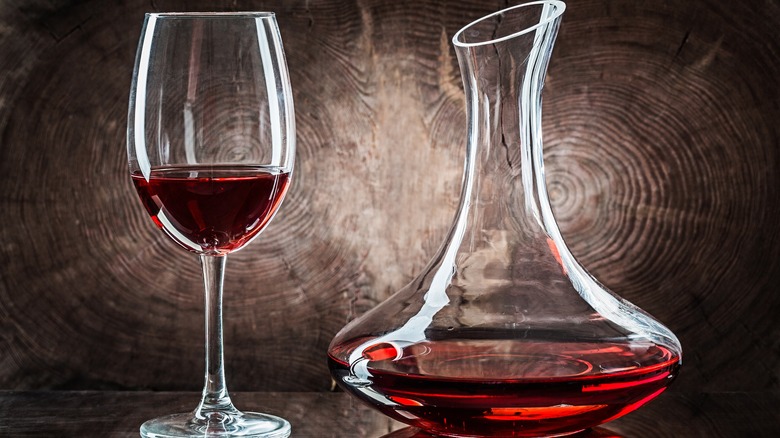What Is The Point Of Aerating Wine?
Imagine it's Friday evening. The workweek is finally over, and you've just returned home with the best bottle of Costco bargain wine you could find. And just as you're about to uncork it with your friends, one of them says you have to "let it breathe." What does that even mean?
The process is called aeration, and it's quite important. Exposing the wine to oxygen allows it to develop its full bouquet by softening the tannins; the compounds responsible for a wine's bitterness and astringency. This also helps eliminate any undesirable flavors that may have developed while the wine was sealed inside the bottle.
Alright, that sounds like another interesting fact to keep in mind for the next wine adventure. But how exactly do you even begin aerating wine? Well, even though wine can be aerated while still inside an uncorked bottle, which typically takes no more than a couple of hours, that technique is slower than using an aerator or a decanter. But no matter which method you choose, it's important to let the wine come into contact with air, as two major reactions — oxidation and evaporation — need to take place to bring it to its ultimate state.
What happens when you aerate wine?
Have you ever opened a bottle of wine and noticed a slightly pungent smell? That's ethanol, a byproduct of the fermentation process that plays a great role in shaping the wine's sensory profile. This is where evaporation comes in handy. It not only helps whisk off the ethanol odor but also clears out unneeded sulfites. Even though these sulfites help battle microbes, nobody wants their first sip smelling like rotten cabbage.
While evaporation filters out the smell of alcohol, oxidation plays a slightly different role. It helps in smoothing the tannins. These phenolic acids are crucial for the wine's aging process and contribute to its texture and appearance (even though you should never rely on color alone when ordering wine). Even so, tannins can be harsh on the palate and can leave a puckering sensation on the tongue. While subtle oxidation can bring out the wine's complexity and highlight its finest notes, too much can compromise its flavor. But don't worry — there are still plenty of ways to keep your wine safe from coming into too much contact with air. Take, for instance, this clever storage hack to save an opened bottle of red.
Which wines need aeration?
While aeration plays a great role in quality wine tasting, understanding which wines benefit from it is another important point to consider. After all, you wouldn't want to take away the fruitiness of a light red like pinot noir or grenache by overexposing it to air. This will spoil it, make it dull, and leave you wondering if you bought a bottle that had already gone bad.
Unlike lighter wines, robust reds, such as cabernet sauvignon, merlot, and nebbiolo, boast a greater aging potential and, as a result, respond well to aeration. This is because their high tannin content, which in a California cabernet sauvignon can reach up to 1,500 milligrams per liter, requires a bit of mellowing. As wine ages, tannins bind onto larger molecules, which reduces their bitterness and softens them. However, in younger red wines, tannins can be quite sharp. That's why these wines often need to be aerated as well.
While white wines don't have as many tannins as reds — their tannin content can be as low as 40 milligrams per liter — it's a common misconception that they shouldn't be aerated. In fact, light aeration can work wonders for oak-aged whites and other full-bodied Bordeaux or Burgundy wines, allowing them to open up and release their hidden complexity.


